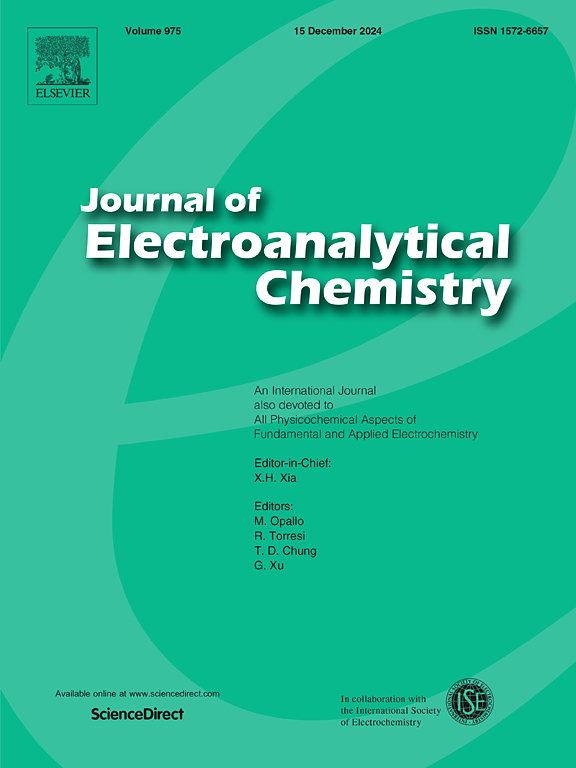金属镍基电解析氧催化剂的研究进展
IF 4.1
3区 化学
Q1 CHEMISTRY, ANALYTICAL
引用次数: 0
摘要
作为一种关键的可再生能源载体,氢已成为化石燃料的清洁和可持续替代品,在工业发展、农业现代化和日常生活应用方面具有巨大潜力。在各种制氢技术中,质子交换膜(PEM)水电解是最有前途的绿色制氢方法之一。然而,由于阳极析氧反应(OER)固有的缓慢动力学,导致产氢效率降低和催化剂降解加速,该技术的实际实施面临着巨大的挑战。这些限制突出了开发具有高活性和长期耐用性的具有成本效益的OER电催化剂的迫切需要。本文首先介绍了OER机制的两种反应途径:常规吸附质演化机制(AEM)和晶格氧介导机制(LOM)。然后总结和讨论了用于OER的非贵金属镍基电催化剂的最新进展,这些催化剂已显示出显着的实际应用潜力。我们综合分析了各种催化剂优化策略,包括形态控制、异质结构、合金化、杂原子掺杂、复合策略、单原子催化剂工程等策略。最后,展望了新一代镍基OER电催化剂的发展机遇与挑战。本文章由计算机程序翻译,如有差异,请以英文原文为准。
Research progress on metallic Ni-based catalysts for electrolytic oxygen evolution reaction
As a pivotal renewable energy carrier, hydrogen has emerged as a clean and sustainable alternative to fossil fuels, offering significant potential for industrial development, agricultural modernization, and daily life applications. Among various hydrogen production technologies, proton exchange membrane (PEM) water electrolysis stands out as one of the most promising approaches for green hydrogen generation. However, the practical implementation of this technology faces substantial challenges due to the inherently sluggish kinetics of the anodic oxygen evolution reaction (OER), resulting in compromised hydrogen production efficiency and accelerated catalyst degradation. These limitations highlight the urgent need to develop cost-effective OER electrocatalysts with enhanced activity and long-term durability. This review first introduces the two reaction pathways of OER mechanisms: the conventional adsorbate evolution mechanism (AEM) and the lattice oxygen-mediated mechanism (LOM). It then summarizes and discusses recent advances in non-precious metal Ni-based electrocatalysts for the OER, which have demonstrated remarkable potential for practical applications. We comprehensively analyze various strategies for catalyst optimization, including morphological control, heterostructure, alloying, heteroatom doping, composite strategies, single-atom catalyst engineering, and other strategies. Finally, we present a forward-looking perspective on the challenges and opportunities in developing next-generation Ni-based OER electrocatalysts.
求助全文
通过发布文献求助,成功后即可免费获取论文全文。
去求助
来源期刊
CiteScore
7.80
自引率
6.70%
发文量
912
审稿时长
2.4 months
期刊介绍:
The Journal of Electroanalytical Chemistry is the foremost international journal devoted to the interdisciplinary subject of electrochemistry in all its aspects, theoretical as well as applied.
Electrochemistry is a wide ranging area that is in a state of continuous evolution. Rather than compiling a long list of topics covered by the Journal, the editors would like to draw particular attention to the key issues of novelty, topicality and quality. Papers should present new and interesting electrochemical science in a way that is accessible to the reader. The presentation and discussion should be at a level that is consistent with the international status of the Journal. Reports describing the application of well-established techniques to problems that are essentially technical will not be accepted. Similarly, papers that report observations but fail to provide adequate interpretation will be rejected by the Editors. Papers dealing with technical electrochemistry should be submitted to other specialist journals unless the authors can show that their work provides substantially new insights into electrochemical processes.

 求助内容:
求助内容: 应助结果提醒方式:
应助结果提醒方式:


